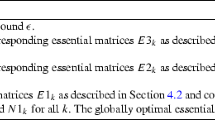Abstract
Given two images, the optimal triangulation of a measured corresponding point pair is to basically find out the real roots of a 6-degree polynomial. Since for each point pair, this root finding process should be done, the optimal triangulation for the whole image is computationally intensive. In this work, via the 3D cone expression of fundamental matrix, called the fundamental cone, together with the Lagrange’s multiplier method, the optimal triangulation problem is reformulated. Under this new formulation, the optimal triangulation for a measured point pair is converted to finding out the closest point on the fundamental cone to the measured point in the joint image space, then 3 efficient suboptimal algorithms, each of them can satisfy strictly the epipolar constraint of the two images, are proposed. In our first suboptimal algorithm, the closest point on the generating cone to the measured point is used as the approximation of the optimal solution, which is to find out the real roots of a 4-degree polynomial; in our second suboptimal algorithm, the closest point on the generating line to the measured point is used as the approximation of the optimal solution, which is to find out the real roots of a 2-degree polynomial. Finally, in our third suboptimal algorithm, the converging point of the Sampson approximation sequence is used as the approximation of the optimal solution. Experiments with simulated data as well as real images show that our proposed 3 suboptimal algorithms can achieve comparable estimation accuracy compared with the original optimal triangulation, but with much less computational load. For example, our second and third suboptimal algorithms take only about a 1/5 runtime of the original optimal solution. Besides, under our new formulation, rather than recompute the two Euclidian transformation matrices for each measured point pair, a fixed Euclidian transformation matrix is used for all image point pairs, which, in addition to its mathematical elegance and computational efficiency, is able to remove the dependency of the resulting polynomial’s degree on the parameterization of the epipolar pencil in either the first image or in the second image, a drawback in the original optimal triangulation.
Similar content being viewed by others
Explore related subjects
Discover the latest articles, news and stories from top researchers in related subjects.References
Anandan, P., & Avidan, S. (2000). Integrating local affine into global projective images in the joint image space. In European conference on computer vision (pp. 907–921).
Hartley, R., & Schaffalitzky, F. (2004). L∞ minimization in geometric reconstruction problems. In Conference on computer vision and pattern recognition (pp. 504–509).
Hartley, R., & Seo, Y. (2008). Verifying global minima for L2 minimization problems. In Conference on computer vision and pattern recognition.
Hartley, R., & Sturm, P. (1997). Triangulation. Computer Vision and Image Understanding, 68(2), 146–157 1997.
Hartley, R., & Zisserman, A. (2003). Multiple view geometry in computer vision (2nd ed.). Cambridge: Cambridge University Press.
Kahl, F., & Hartley, R. (2008). Multiple-view geometry under the L∞ norm. IEEE Transactions on Pattern Analysis and Machine Intelligence, 30(9), 1603–1617.
Kahl, F., Agarwal, S., Chandraker, M. K., Kriegman, D., & Belongie, S. (2008). Practical global optimization for multiview geometry. International Journal of Computer Vision, 79(3), 271–284.
Ke, Q., & Kanade, T. (2007). Quasiconvex optimization for robust geometric reconstruction. IEEE Transactions on Pattern Analysis and Machine Intelligence, 29(10), 1834–1847 2007.
Lu, F., & Hartley, R. (2007). A fast optimal algorithm for L2 triangulation. In Proceedings of the Asian conference on computer vision (pp. 279–288).
Olsson, C., Kahl, F., & Hartley, R. (2009). Projective least-squares: global solutions with local optimization. In Conference on computer vision and pattern recognition (pp. 1216–1223).
Sampson, P. D. (1982). Fitting conic sections to “very scattered” data: an iterative refinement of the Bookstien algorithm. Computer Vision, Graphics, and Image Processing, 18, 97–108.
Stewenius, H., Schaffalitzky, F., & Nister, D. (2005). How hard is 3-view triangulation really. In Proceedings of the international conference on computer vision (pp. 686–693).
Torr, P. H. S., & Zisserman, A. (1997). Robust parameterization and computation of the trifocal tensor. Image and Vision Computing, 15, 591–605.
Torr, P. H. S., & Zisserman, A. (1998). Robust computation and parameterization of the multiple view relations. In Proceedings of the international conference on computer vision (pp. 727–732).
Zhang, Z. (1998). Determining the epipolar geometry and its uncertainty—a review. International Journal of Computer Vision, 27(2), 161–195.
Author information
Authors and Affiliations
Corresponding author
Rights and permissions
About this article
Cite this article
Wu, F.C., Zhang, Q. & Hu, Z.Y. Efficient Suboptimal Solutions to the Optimal Triangulation. Int J Comput Vis 91, 77–106 (2011). https://doi.org/10.1007/s11263-010-0378-y
Received:
Accepted:
Published:
Issue Date:
DOI: https://doi.org/10.1007/s11263-010-0378-y




